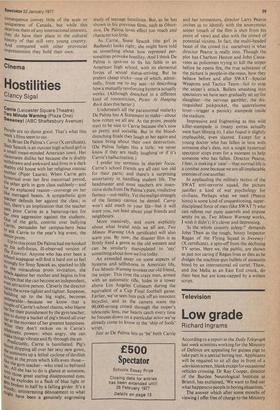Art
Below deck
John McEwen
Nigel Waymouth's first one-man exhibition (Fischer Fine Art till 11 February) is of drawings and photo-realist portraits in acrylic, tempera and oil. Waymouth came to painting through commercial design, becoming a full-time artist in 1971, and his debuts shows examples of work from that date to the present, so should be studied as a progression. That he had mastered the tricks of his former trade is made quite clear by the smooth technique of 'Nicky in the Chelsea Hotel' 1971, since when he has become more painterly. Necessarily therefore most of the work is transitional and uneven, but the assurance and technical ability (water is always a test) of 'Girl Reflected in a Pool,' the delicacy of 'Broken Light Bulb' and the freer handling of his recent drawing promise well.
There is nothing wrong with popularising art. In the gay old days of the School of Paris, and even in America now, artists tried their hand at anything, often with inspirational results; so that Christian Neffe's (he's French, needless to say) idea of asking fifty-four of his favourite British artists to design one face each of a full pack of cards for his Christmas show deserves commendation. Not everyone invited wanted to or could contribute but the gaps were filled and the assembled deck is on view at his gallery, JPL Fine Art, until the end of this month. Ideally this should have been worth marketing, in the hope that the styles of the artists involved would become familiar to a wider audience and perhaps lead to a greater interest in their work. Unfortunately the incomprehensibility of too many of the designs will make this impossible. Another failure is that the majority of the artists invited did not bother to think of the commission in terms of design, and have aceordingly rattled off a scaled-down piece of their own work, legibly emblazoned or not, just to keep in the swim. Perhaps Neffe should have been more rigorous in his specifications. The best designs, therefore, come from those whose work is graphicallY strong in any case. For Allen Jones, with his fetishistic queen of clubs, and Anthony Donaldson, with a stripteasing joker, it was a gift. They should be signed on to do one pack apiece immediately. So should Patrick Caulfield for his ace of diamonds. But the most praiseworthy, because of the way it so neatly harnesses his style to the demands of the format, is Howard Hodgkin's four of clubs.
Doors (Camden Arts Centre till 30 January) is a very similar idea to the cards, but fails as an exhibition through indecision. It starts, of course, as a great survey of doors through the ages and from every land, but after soberly displaying a dozen or so of these deteriorates into a large assembly of work by, on the whole, indifferent contemporary artists, all of whom have Pr0. duced something in their time vaguely expressive of the subject on exhibition. This hopelessly sudden transition is quite tni adequately bridged by a non-stop show haphazardly chosen and, for the most part. very poor quality slides. Popularising the best in art is one thing, confusing the public is another. Apart from Paolozzi, wh° does actually present the full-scale model for a real door, and three nice prints by Btrg,it Skiold, the standard of this oppressivelY, large section rarely rises above the abysnlai norm one has come to expect from the Camden Arts Centre. You come out having forgotten how well it all began. The 'Group of Seven' (Canada House till 23 February) were the first Canadians t°a paint Canada as professional artists with degree of academic competence. TileIrl largely impressionistic landscapes neve..., really break free of their derivations and "' consequence convey little of the scale or Uniqueness of Canada, but while this deprives them of any international interests, they do have their place in the cultural history of that still very young country. And compared with other provincial Impressionists they hold their own.



































 Previous page
Previous page